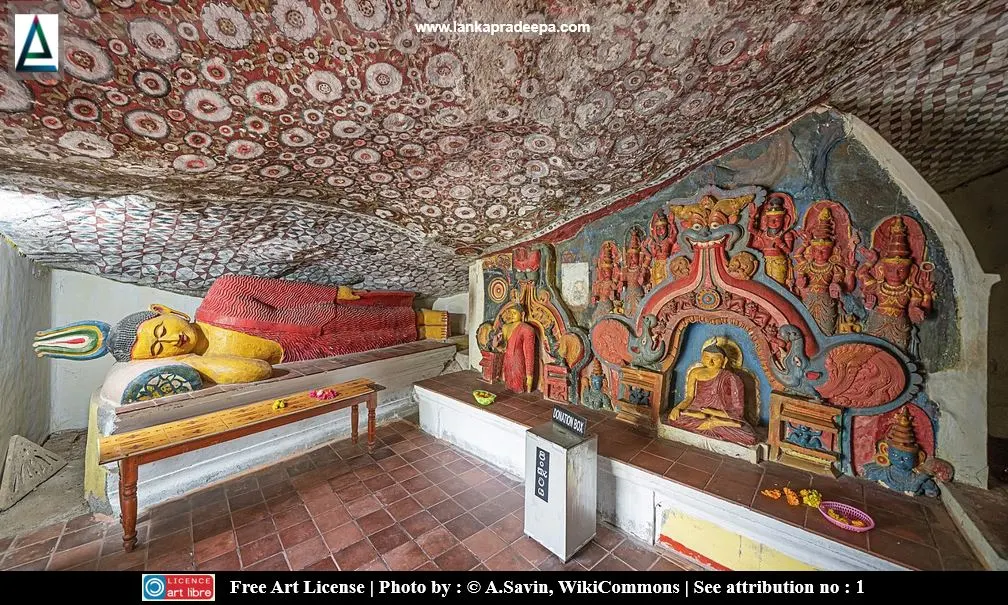
Ravana Ella Purana Viharaya, also known as Ravana Ella Cave temple (Sinhala: රාවණා ඇල්ල විහාරය හා ගුහාව), is a Buddhist temple situated in the village of Ravana Ella in Badulla District, Sri Lanka.
History
Locals believe that this temple was established during the reign of King Valagamba (103 B.C. & 89-77 B.C.). The drip-ledged cave and the paintings and sculptures in the image house depict features belonging to the Kandyan Period.
The image house
The image house of Ravana Ella temple is archaeologically important. The sculptures in the image house are apparently old but they have been coloured with modern-day paints. The roof of the cave (the inner surface) is plastered using a thin layer of mortar on which the paintings of circular patterns of lotuses, creeper designs, and floral designs are found. The old inner walls and the tiled canopy of the cave have been recently restored.
Ravana Cave
The cave popularly known as Ravana-guhava is located close to the Ravana Ella cave temple. The excavations carried out in this cave by the Department of Archaeology on several occasions have revealed evidence of human habitation dating back to 25,000 years.
As a place related to Ravana?
Without any archaeological or historical evidence, this cave is presently promoted by some locals and tourist agencies as a place related to Ravana and Seetha, two mythical figures in the Indian epic Ramayanaya. According to them, Ravana had used this cave to imprison Sita before relocating her to a pleasure garden near Nuwara Eliya. However, the authenticity of the Ramayanaya is controversial and hence it is today dismissed as a myth (Goonatilake, 2010).
A protected site
The image house with ancient paintings at Rawana Ella Viharaya and the pre-historic cave located in the 69A and 68D Ravana Ella Grama Niladhari Division in the Ella District Secretariat Division are archaeological protected monuments, declared by two government gazette notifications published on 1 November 1996 and 1 February 2023.


.
Attribution
1) SL Ella asv2020-01 img11 Ravana Temple by A.Savin is under the Free Art License 1.3
2) SL Ella asv2020-01 img14 Ravana Temple by A.Savin is under the Free Art License 1.3
3) SL Ella asv2020-01 img04 Ravana Cave by A.Savin is under the Free Art License 1.3
3) SL Ella asv2020-01 img04 Ravana Cave by A.Savin is under the Free Art License 1.3
References
1) Goonatilake, S., 2010. Introduction: Inventing Archaeology: The Tourist Board's "Ramayana Trail".
2) The Gazette of the Democratic Socialist Republic of Sri Lanka. No: 948. 1 November 1996.
3) The Gazette of the Democratic Socialist Republic of Sri Lanka: Extraordinary. No: 2317/57. 1 February 2023. p.8A.
2) The Gazette of the Democratic Socialist Republic of Sri Lanka. No: 948. 1 November 1996.
3) The Gazette of the Democratic Socialist Republic of Sri Lanka: Extraordinary. No: 2317/57. 1 February 2023. p.8A.
Location Map
This page was last updated on 11 April 2023
A short note for local school students
රාවණා ඇල්ල පුරාණ විහාරය
රාවණා ඇල්ල පුරාණ විහාරය/ රාවණා ඇල්ල ලෙන් විහාරය ශ්රී ලංකාවේ බදුල්ල දිස්ත්රික්කයේ රාවණා ඇල්ල පිහිටි බෞද්ධ සිද්ධස්ථානයකි.
ඉතිහාසයප්රාදේශීයයන්ගේ විශ්වාසයන්ට අනූව මෙම විහාරය වළගම්බා රජු දවස (ක්රි.පූ. 103 සහ 89-77) ඉදිකරන ලද්දකි. කටාරම් කෙටූ ලෙන හා විහාර මන්දිරයෙහි (ලෙන් විහාරය) දැකගත හැකි සිතුවම් හා මූර්ති නුවර යුගයෙහි කලා ලක්ෂණ පෙන්වයි.
ලෙන් විහාරයරාවණා ඇල්ල විහාරස්ථානයෙහි ලෙන් විහාරය පුරාවිද්යාත්මකව වැදගත් වේ. එහි වූ මූර්ති පැරණි බැව් පෙනෙන්නට ඇති මුත් ඒවා වර්තමාන තීන්ත වලින් වර්ණ ගන්වා ඇත. ලෙනෙහි වියන් පෘෂ්ඨය තුනී බදාමයකින් කපරාරු කොට ඇති අතර එහි කවාකාර නෙළුම් මල් මෝස්තර, ලියවැල් හා මල්වැල් මෝස්තර දැකගත හැකිය. පැරණි ඇතුල් බිත්ති හා උළු සෙවිලි කල පියස්ස මෑතකාලීනව නවීකරණය කර තිබේ.
රාවණා ගුහාවරාවණා ගුහාව නමින් ප්රචලිත ගල් ගුහාව රාවණා ඇල්ල ලෙන් විහාරය ආසන්නයේම පිහිටා තිබේ. පුරාවිද්යා දෙපාර්තමේන්තුව විසින් මෙහි කිහිපවරක් සිදුකරන ලද කැණීම් වලදී වසර 25,000 ක් පමණ පැරණි මානව සාධක හෙළි කරගෙන ඇත.
රාමායනයට සබැඳි ස්ථානයක්?
කිසිදු පුරාවිද්යා හෝ ඉතිහාසමය සාධකයක් රහිතව මෙම ගුහාව සමහර ප්රාදේශීයයන් හා සංචාරක ප්රවර්ධකයන් විසින් හඳුන්වනු ලබන්නේ ඉන්දියානු රාමායනයෙහි දැක්වෙන මිත්යා චරිත ද්විත්වයක් වූ රාවණා සහ සීතා හා සබැඳෙන ස්ථානයක් වශයෙනි. ඔවුන්ට අනූව, රාවණා විසින් සීතාව නුවර එළිය ආසන්නව පිහිටි උද්යානයකට ගෙන යාමට පෙර මෙහි රඳවා තබා තිබේ. කෙසේනමුදු, රාමායනයෙහි සත්යතාවය මතබේදාත්මක වන බැවින් වර්තමානයේදී එය මිත්යාවක් ලෙස බැහැර කෙරේ.
පුරාවිද්යා ස්මාරක ස්ථානයඇල්ල ප්රාදේශීය ලේකම් කොට්ඨාශයේ 69A රාවණා ඇල්ල ග්රාම නිළදාරී වසමට අයත් රාවණා ඇල්ල විහාරයෙහි පිහිටි පුරාණ ලෙන් විහාරය 1996 නොවැම්බර් 1වන දින ප්රකාශයට පත් රජයේ ගැසට් නිවේදනය මගින් ආරක්ෂිත පුරාවිද්යා ස්මාරකයක් ලෙස නම් කොට ඇත.

